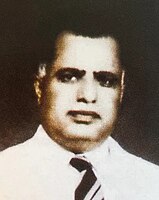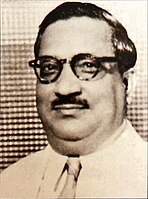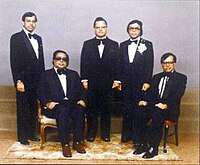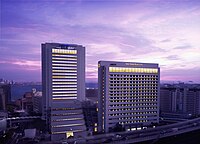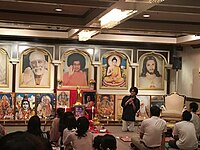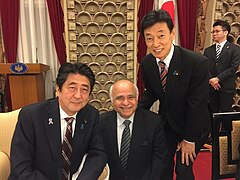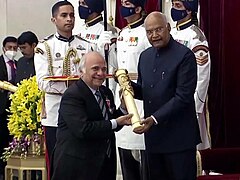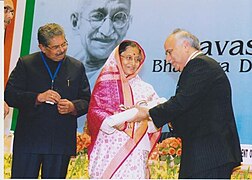Ryuko Hira
Padma Shri Ryuko Hira | |
|---|---|
 Official Portrait of Ryuko Hira | |
| Born | May 30, 1948 Jaipur, Rajasthan, India |
| Occupation(s) | Investor, Philanthropist |
| Organization | HMI Hotel Group |
| Known for | Trade and Tourism, Indo-Japan Relations, Sri Sathya Sai Baba |
| Parent |
|
| Awards | Padma Shri Award 2022, Pravasia Bharatiya Samman Award 2010 |
| Website | https://hmihotelgroup.com/corporate/ |
Ryuko Hira (比良 竜虎) (born May 30, 1948) is a renowned investor, and philanthropist, President of HMI Hotel Group and Ora Group of companies in Japan, engaged in the investment, ownership, and development of real estate, hospitality, and tourism projects in railways, airports, seaports, and public transportation located in 31 cities in Japan. He plays a pivotal role in directing Japanese investments towards India and is a pioneer in establishing cooperation agreements between several Indian state governments and Japanese prefectures. Hira’s family has been engaged in business in Japan since 1918. As of 2018, Japan Times reports him being the largest single Indian investor in Japan with US$ 2.5 billion in investments and over US$10 billion in net worth.[1] Hira was conferred with the prestigious Padma Shri Award in 2022 by the President of India for his contribution to trade and industry.[2] He is also widely known for his involvement in Indo-Japan economic exchanges, promotion of Indian culture, and his devotion to Sri Sathya Sai Baba.
Early life[edit]
Hira was born in Jaipur (Rajasthan), India, in the 'Parijat' Bungalow, which today houses the 'Dena Bank.' He attended the Hill Grange High School, Mumbai and, after completing his Senior Cambridge, received his Secondary School Certificate from the Maharashtra Board of Education at Sitaram Prakash High School in Mumbai. Hira graduated in gemmology from the Gemological Institute of America (G.I.A.), and attended a 12-week course at the Cornell University School of Hotel Administration. He also completed a Japanese language course from Sophia University, Tokyo. Additionally, Hira has a diploma in character development from the Institute of Sathya Sai Education, Japan.[3]
Family background[edit]
Hira’s family traces its lineage to the 18 century with the birth of his great grandfather Seth Jagatrai in Hyderabad, Sindh Province (now in West Pakistan). Due to the same filial name, the family was also known as the Jagtianis. The Jagtianis had a history of engaging themselves in the procurement of jewels and ornaments from Muslim Royalty or Mirs. Working with foresight and dynamism, the Jagtianis had spread over four generations and expanded their trading business beyond the Indian sub-continent into South East Asia and Japan.
The Anglo-Japanese Alliance which was in operation from 1902 to 1922 allowed 50 Indian companies to set up their operations in Japan. It was Hira's uncle, Shri Pitamberdas Merghraj, who first partnered in the firm of Dalamals in Yokohama (Japan). Soon after, he independently engaged in the export of silk from Yokohama to British India in 1918. The business flourished, and was joined by other family members. Later, due to the Great Kanto Earthquake, in 1923 the business establishment had to be shifted to Kobe, where the family business shifted to buying cultivated corals for export to India. The corals were cultivated then in Shikoku and processed in Kobe. However the damages from the Great Kanto Earthquake caused severe setbacks to the business. Moreover, coral cultivation had to be ceased during the Korean War of 1952 due to sea mines by the Japanese Navy.
The post-World War II period saw rapid industrialization and modernization in Japan. Hira's two brothers, Shri Lokram and Shri Chandiram, who had established offices in Singapore, Thailand, and Hong Kong in 1950, started visiting Japan to study its business potential. However, the family was hit by concurrent tragedies occurring one after another. Hira's father - Shri Khemchand, his second uncle - Shri Parsram, and his eldest brother - Shri Lokram, passed away in the same year. The sudden and unexpected death of three responsible members of the family brought the business responsibilities on young Hira’s shoulders to help his brother Chandiram.
While in Hong Kong, Hira learned the business under guidance of Chandiram. The business office was shifted to Tokyo in 1966. Hira raised the business to great heights that his company became one of the most prominent foreign businesses in Japan. The business was broadcast through a one-hour special documentary hosted by Japan’s National Television, NHK, on December 2, 1984. Upon the untimely death of Shri Chandiram in 1986, the family estate was amicably shared, and Hira was entrusted the real estate development business. Thereafter, through talent, experience, and traditions of family lineage, Hira laid the foundation for the Ora Group of Companies in 1986.[3]
- Seth Kundamal Chandumal Panjabi in 1890. Hira's grandfather who was the founder of V. Kundamal Chandumal Jewellers.
- Seth Khemnchand Kundamal Panjabi in 1960s. Hira's father who was the second generataion in family business.
- Seth Parsram Viroomal Panjabi in 1940s. Hira's uncle who was second generation in the family business.
- Ryuko Hira with his brothers (from the left) Rajesh, Chandiram, Hiro, Kamlesh (Ryuko), and Premji.
Career[edit]
Hira has been engaged in investments and real estate for over 55 years in Japan. He began his career in Japan by investing in Sunroute Hotel Systems Co. Ltd. in 1970 and has ever since been particularly active in developing tourism infrastructure, including the development of railways, transportation, seaports, airports, and airline businesses. Hotel Management International (HMI Hotel Group) Ltd., his flagship hotel management company, and its group of companies are engaged in ownership and management of hotels and resorts, as well as property development, construction of new towns, housing complexes, hotels, and provision of hotel management services. After commencing his real estate development business in 1985, Hira developed the HMI Hotel Group, which receives more than 13.7 million lodging guests annually, and ranks as the 8th largest hotel chain in Japan by the Nikkei Marketing Journal on November 11, 2020. Hira's Hotel Management International Co. Ltd currently manages owns and manages 45 hotels in 24 prefectures of Japan under 7 brands (Hotel Crown Palais, Hotel Pearl City, Creston Hotels, Ryokans, Resort Hotels, Hotel Wellness and Top Wellness).
Hira’s group companies also specialize in proprietary hotel management businesses, hotel management services, services for raising capital using building leases and trusts, hotel planning and development services, property management services, technical consulting services, and hotel supplies businesses. The companies had a pivotal role in the real estate development of the Naha Airport Terminal Co., Ltd., KitaKyushu Air Terminal Co., Ltd. and Kobe Airport Terminal Co., Ltd. Some of the major hotels under his management include Rizzan Sea-Park Hotel, the largest hotel in Okinawa with 826 rooms, Harborland Centre Building, a large scale complex building facing the JR Kobe station, and Tsumagoi Resort - Sai No Sato, an expansive lush-green 140 hectare resort renowned for music and sports events. For the promotion of Japan-India tourism exchanges, Hira often serves as an advisor to the Ministry of Land, Infrastructure, Transport, and Tourism of Japan, the Japan Tourism Agency, and Ministry of Tourism of India.
- Representative HMI Hotel Group Properties across Japan
- Rizzan Sea-Park Hotel in Tancha Bay, Okinawa Prefecture, the largest hotel in Okinawa with 826 rooms
- Hotel Pearl City Kobe in Kobe City, Hyogo Prefecture
- Hotel Crown Palais Kobe, and Harborland Centre Building, a large scale complex building facing the JR Kobe station in Kobe City, Hyogo Prefecture
- Tsumagoi Resort - Sai No Sato in Kakegawa City, Shizuoka Prefecture. An expansive lush-green 140 hectare resort renowned for music and sports events
Amongst many honours, Hira and his group of companies have had the distinction of hosting His Highness Crown Prince Naruhito in 1998, and Their Majesties, Emperor Akihito and Empress Michiko in June 2008, and several other state guests. During the 2000 G8 Summit, many of the meetings were hosted at the group company’s Rizzan Sea-Park Hotel in Okinawa. The hotel hosted the stay of the French President Jacques Chirac, and the Canadian Prime Minister Jean Chrétien, and other leaders of the 2000 G8 Summit.[3]
- Ryuko Hira with President Jacques Chirac of France during the G8 Summit of 2000 in Rizzan Sea-Park Hotel
- Ryuko Hira with Prime Minister Jean Chrétien of Canada during the G8 Summit of 2000 in Rizzan Sea-Park Hotel
In recency, Hotel Management International Co., Ltd. signed an MOU with the government of Uttar Pradesh regarding hotel development businesses at the "UP Global Investor Summit 2023" held in Lucknow, the capital of Uttar Pradesh, India on February 11, 2023, according to Hindustan Times. The MOU will involve the development of 30 chain hotels and the acquisition of existing national hotel operations in commercially viable business and tourism destinations, in conjunction with U.P.'s economic and tourism growth plans, with an investment of ¥130 billion (US$1 billion x ¥130) and the employment of approximately 10,000 people.[4]
Social contributions[edit]
Hira’s contribution to social service is unaffected by his involvement in managing vast businesses. The Central and Local Government authorities in Japan appreciate Hira's expertise knowledge of Japan's real estate market and hotel & tourism industry. Owing to such recognitions, he was elected as a member of many advisory councils in the country and entrusted with respectable positions in various organizations and institutes. His advice is often sought after by government authorities and businessmen alike, especially pertaining to Indo-Japanese affairs. He was elected as the first Indian Director of the Japan-India Association in June, 2004. He is also the representative director of ‘Sai Hira India Foundation’ which is a charitable organization to increase the public benefit between Japan and India through tourism, economics, philosophy and culture.
He has actively promoted Indian culture and its traditional values in Japan. He has built prayer halls nationwide where Japanese ladies and men chant the Vedas and sing Bhajans. The volunteers cook 20,000 meals annually for homeless people at these prayer halls. Though many other institutions distribute free food, the homeless people of Tokyo say the lunch box from these Sai Baba prayer halls are the most delicious. Hira said that all the volunteers chant hymns and prayers while cooking, praying for the recovery of the homeless. Hira, who has built five such prayer halls for community service, describes this as the passion and mission of his life. Additionally, Hira's association with Sathya Sai Publications Japan, which was inspired by Sri Sathya Sai Baba and his teachings, has been of great importance to him.
- Sri Sathya Sai Prayer Halls in Japan
- Sri Sathya Sai Prayer Hall in Tokyo, Tokyo Prefecture
- Sri Sathya Sai Prayer Hall in Yokohama City, Kanagawa Prefecture
- Sri Sathya Sai Prayer Hall in Osaka, Osaka Prefecture
- Sri Sathya Sai Prayer Hall in Kyoto, Kyoto Prefecture
During H.H. Dalai Lama’s visit to Japan in November 2009, Hira hosted his holiness at the Okinawa Prefecture Peace Memorial Park. He also led an economic delegation to India in November 2015, which was notably participated by Mr. Osamu Suzuki, Chairman of Suzuki Motor Corporation, which attended the 34th Convocation of the Sri Sathya Sai Institute of Higher Learning. In Prashanti Nilayam, the delegation was also guided by Hira to the largest statue in the world of Lord Hanuman, the Hindu deity, who is also knows as “Maruti” - India’s largest brand of Maruti Suzuki Cars. In 1990, Hira patronized the construction of Sri Sathya Sai Institute of Higher Medical Sciences in Puttaparthi, which was inaugurated by the Prime Minister of India P.V. Narasimha Rao in 1991, and in 2000, the construction of the Chaitanya Jyoti Museum in Prashanti Nilayam, Puttaparthi, India.
In October 2017, the 72nd Arts Festival by the Agency of Cultural Affairs in Japan, and the ‘2017 - The Year of Japan-India Friendly Exchanges’ which was adopted by the Governments of Japan and India, were conducted. During this, the great Indian epic ‘Mahabharata’ was historically produced by the National Kabuki Theatre in Japan under the title ‘The War Chronicles of Mahabharata’. The production was delivered in a traditional Kabuki style artform. Renowned Kabuki actors such as Onoe Kikunosuke, Bando Tamasaburo, and Onoe Kikugoro VII were part of its cast. As a commemoration of the 70th year of Indo-Japan relations, and the centenary anniversary of the Indian Commerce and Industry Association Japan (ICIJ), Hira and the Okinawa-India Friendship Association hosted a special screening of ‘The War Chronicles of Mahabharata’.
In October 2019, Hira hosted the foundation stone ceremony for the Sri Sathya Sai Sanathana Samskruti - Spiritual Centre, as a project to promote further cultural exchanges between India and Japan, at Tsumagoi Resort - Sai No Sato. The project was hosted on collaboration with the Sri Sathya Sai Organization in Japan. The ceremony was attended by chief guest President of India - Ramnath Kovind, First Lady of India Madam - Savita Kovind, and Ambassador of India to Japan Sanjay Kumar Verma, Minister of Land, Infrastructure, Transport, and Tourism - Kazuyoshi Akaba, Suzuki Motor Company Chairman - Osamu Suzuki amongst many other members of parliament and distinguished guests.[5]
- Ryuko Hira alongside President of India Ramnath Kovind, First Lady of India Madam Savita Kovind during the foundation stone ceremony for the Sri Sathya Sai Sanathana Samskruti in Japan in October 2019.
- Ryuko Hira with the Dalai Lama during his visit to Okinawa Prefecture in November 2009.
- Prime Minister of India P.V. Narasimha Rao with Ryuko Hira during the Inauguration of Sri Sathya Sai Institute of Higher Medical Sciences in November 1991.
In July 2023, the 'Sai Hira Global Convention Centre' was inaugurated by Prime Minister of India - Narendra Modi in the august presence of Governor of Andhra Pradesh - Abdul Nazeer at Prashanti Nilayam, Puttaparthi, Andhra Pradesh. During the inauguration, the Prime Minister spoke on the potential and significance of the convention centre, his connection to Sri Sathya Sai Baba, and specifically mentioned about his close relationship with Ryuko Hira during his address. Hira was felicitated and honored during the cerenomny by Sri Sathya Sai Central Trust for his contributions to the Sathya Sai Community. The Prime Minister's official website reports 'The Convention Centre donated by philanthropist Shri Ryuko Hira is a testament to the vision of promoting cultural exchange, spirituality, and global harmony.'[6][7]
- Sai Hira Global Convention Centre
- Prime Minister of India - Narendra Modi addressing the gathering at the inauguration of Sai Hira Global Convention Centre
- Ryuko Hira being felicitated by Sri Sathya Sai Central Trust during the inauguration of 'Sai Hira Global Convention Centre'
Involvement in Indo-Japan relations[edit]
Over the decades, Hira has played a vital role in coordinating agreements, memorandums, and its likes amongst various tier governments of India and Japan. Some prominent examples of Hira's contribution as a co-ordinator can be noted in the following memorandums:
| Year | Month | Memoranda |
|---|---|---|
| 2018 | October | Ministry of Ayush - Kanagawa Prefecture MOU |
| 2016 | November | State of Gujarat - Hyogo Prefecture MOC |
| 2016 | August | Gujarat - Hyogo Goodwill, Education and Economic Delegation |
| 2016 | March | State of Karnataka - Mie Prefecture MOU |
| 2015 | December | State of Kerela - San In District MOU |
| 2015 | December | Establishment of Toyama - India Association |
| 2015 | December | Andhra Pradesh - Toyama Memorandum of State Level Cooperation |
| 2015 | November | Japan Advanced Institute of Science and Technology - Sri Sathya Sai Institute of Higher Education Comprehensive Memorandum of Understanding |
| 2015 | November | Andhra Pradesh - Shizuoka, Ishikawa Economic and Education Delegation |
| 2015 | July | Rajasthan - Aichi Economic Delegation |
| 2014 | September | India-Japan Tourism Treaty |
| 2013 | October | Maharashtra - Wakayama Comprehensive MOU |
| 2002 | - | Okinawa-India Friendship Association |
Hira was amongst the distinguished guests invited to attend the welcome dinner hosted by the President of India - Pranab Mukherjee at Rashtrapati Bhavan in honor of Their Majesties, Emperor Akihito and Empress Michiko of Japan’s State visit to India in November - December 2013. During this visit, Sai Hira India Foundation sponsored an exhibition at the India International Centre - New Delhi, on the Emperor’s visit to India as Crown Prince fifty three years ago in December 1960.[8] In January 2014, he played a pivotal role in the establishment of a memorandum between the Ministry of Tourism of the Republic of India, and Japan Tourism Agency, Ministry of Land, Infrastructure, Transport, and Tourism. In cooperation with Japan National Tourism Organization (JNTO), Hira’s recommendations resulted in major relaxations of short-term visas for Indian citizens visiting Japan. In January 2016, Hira was invited by the Chief Cabinet Secretary - Yoshihide Suga for an experts meeting at the Prime Minister’s official residence wherein he proposed the policy measures to liberalize tourism from India to Japan in the next 5 years. In April 2016, he delivered a lecture at Ceremonial Occasion Research Institute Co., Ltd. about the culture of ceremonial occasions in India. Hira was also involved in tourism and transport sectors during Prime Minister Modi’s official visit to Japan in November 2016 and October 2018, as well as Prime Minister Abe’s official visit to Indian in September 2017. Hira has participated in the G20 Tourism Ministers’ Meeting held in Niseko, Hokkaido wherein he also attended the Indo-Japan bilateral tourism conference. In October 2019, Hira was noted instrumental in the launch of the new ANA flight route of Narita-Chennai and attended its inauguration ceremony.
- Ryuko Hira with Prime Minister of India - Narendra Modi and Minister of Economy, Trade, and Industry of Japan - Yasutoshi Nishimura
- Ryuko Hira with Governor Naomichi Suzuki of Hokkaido Prefecture during the G20 Tourism Minister’s Meeting in October 2019.
- Ryuko Hira with Prime Minister of India - Narendra Modi during Aichi-India Friendship Agreement in September 2014.
- Sai Hira India Foundation accredited in the ‘Memories of Their Majesties in India 53 years ago’ exhibition in November 2013.
- Ryuko Hira with Prime Minister of Japan - Shinzo Abe and Minister of Economy, Trade, and Industry of Japan - Yasutoshi Nishimura
- Ryuko Hira with Ambassador of India to Japan - Sanjay Kumar Verma and other dignitaries during the Narita-Chennai flight inauguration in October 2019
- Ryuko Hira with Prime Minister of India - Narendra Modi in July 2023
- Ryuko Hira guiding Prime Minister of India - Narendra Modi at the JNTO Robot Pavilion during his State visit in October 2018
- Ryuko Hira with Prime Minister of India - Narendra Modi at the JNTO Robot Pavilion in the Imperial Hotel during his State visit in October 2018
Honors and awards[edit]
- In April 2024, the Minister of Land, Infrastructure, Transport and Tourism Japan (Tetsuo Saito) conferred the ‘National Award of Honor for Tourism’ and felicitated Hira for his remarkable and long time (40 years) accomplishments in the hotel industry of Japan.[9]
- In 2023, Sri Sathya Sai Central Trust and the Governor of Andhra Pradesh - Abdul Nazeer honored and felicitated Hira for his contributions to the establishment of 'Sai Hira Global Convention Centre'.
- In 2022, the President of India conferred on Hira the Padma Shri award for his distinguished service in the field of trade and industry, in recognition of his service as a "senior business leader in Japan instrumental in promoting India-Japan friendship."[2]
- In 2022, Hira was honoured jointly by the Cabinet Office of Japan, and the Director of the Okinawa General Bureau for his substantial contribution to the tourism and land transportation industry in Okinawa Prefecture. Apart from this, he has also been conferred with several Japanese travel and tourism industry awards.[10]
- In 2010, the President of India conferred on Hira the Pravasia Bharatiya Samman award, for his entrepreneurship and his contribution to the Indian community in Japan in the cultural, economic and social fields.[11]
- In 1998, Hira was honoured at the Great Hall of the People during Madame Chiang Kai-shek`s 100th birth anniversary for hosting the first All China Provinces' Human Values Essay Contest.[12]
- In 1992, Hira was honoured for his contribution to, and lectures of Buddhism at, the ‘First Conference in Korea for Teachers to Introduce Human Values (EHV)’ by the Sathya Sai Organization of Korea at the Dongguk University, Seoul, Korea.[12]
- Ryuko Hira being conferred the National Award of Honor by Minister of Land, Infrastructure, Transport and Tourism, Tetsuo Saito in April 2024
- Ryuko Hira being awarded Padma Shri in March 2023
- Ryuko Hira amongst fellow Pravasia Bharatiya Samman Awardees in 2010
- Ryuko Hira being honored in Okinawa in 2022
- Ryuko Hira being felicitated by Sri Sathya Sai Central Trust during the inauguration of 'Sai Hira Global Convention Centre' in July 2023
- Ryuko Hira being awarded the Pravasi Bharatiya Samman Award by President Pratibha Patil in January 2010.
Publications[edit]
Hira is a trusted, influential writer and has contributed to and led many commendable and historic publication initiatives. He has written and published 61 articles in major Japanese daily newspapers to raise India's awareness among Japanese readers constantly. In 1974 Hira sponsored and supported 13 Japanese scholars for publications of the first 'Sanskrit, Hindi to-Japanese Dictionary.' In addition, the same team translated and published nine volumes of the great Indian epic 'Mahabharata,' Vedas, and Upanishads, works of Sri Adi Shankaracharya, several books on Buddhism, Sikhism, and a compendium of Hindu Gods and Goddesses. On the 50th anniversary of the 'Indo-Japanese Cultural Treaty' in 2007, the Embassy of India in Japan and the Institute of Sathya Sai Education Japan jointly honoured the Scholars with Awards and Citations. Since 1978 Hira has also sponsored, translated, and published over 132 periodicals and books in the Japanese language on Indian culture and spirituality through the 'Sathya Sai Publications Japan.'

In the following decade, translated by NHK (Japan Broadcasting Corporation), Hira sponsored a Hindi-language commentary for visitors to the Hiroshima Peace Memorial to benefit Indian visitors in 1981. Since 1983, Hira has served as the chief editor of 'Sairam News,' a monthly newsletter published by Sathya Sai Publications Japan. In an affinity survey poll conducted by the cabinet office of Japan in 2010, young Japanese students were found to have no interest in India, mainly due to the non-availability of lesson books introducing India to primary school students of Japan. In response, Hira published a book - 'Secrets of India,' with support of the 'All Japan National Congress of Parent Teacher Associations.' The book was officially released in 2012 by the Embassy of India in Japan on the 60th anniversary of 'India-Japan Diplomatic Relations.' The book was received by 23,500 primary schools and public libraries across Japan, where in five years 2012 - 2017 over seven million Japanese elementary school students have read the book as a study of India.
Most of Hira's books are sold on the Japanese amazon bookstore today. Over 30+ books are placed at national and regional public libraries and the cultural centre library of the Embassy of India in Japan.[3]
Devotion to Sathya Sai Baba[edit]
Hira is widely known for his philanthropy, interest in social causes, and spiritual devotion. He was first introduced to Sri Sathya Sai Baba in 1978 and has ever since been a passionate student of his teachings and message. Inspired by the dictum of the Vedas as well as the teachings of Sri Sathya Sai Baba, Hira is actively engaged in the selfless service of humanity alongside working devoutly for the character-building of people at large. His adoption of the lifestyle of a spiritualist, social worker, and patron of various social causes, began with knowing Sri Sathya Sai Baba.[13][3]
Hira has been instrumental in introducing the teachings and message of Sri Sathya Sai Baba, and was the Chairman of the Sri Sathya Sai Organization Region B which included over 80 countries. He is currently a trustee of the Sri Sathya Sai Central Trust, President of Sathya Sai Publications Japan, and Institute of Sathya Sai Education Japan. Over the years, He has also organized workshops, exhibitions, and symposiums on Gayatri Mantra and its significance, the harms of alcohol and smoking, and the national annual Sai conventions in Japan. A spiritual milestone was achieved on the 80th Birthday of Sri Sathya Sai Baba on 23rd November 2005, when over 100 young Japanese fluently recited the whole of Vedas reverentially in perfect Sanskrit pronunciation without referring to the text from memory. This globalization of cultures from India to Japan is but a glimpse of a spiritual renaissance to be embraced by Japan. In almost a year since then, 300 Japanese have learned to recite the Vedas, with appreciable pronunciation and deciphering their meanings.[12][3]
The ‘Great Tohoku Earthquake and Tsunami’ occurred in the Oshika Peninsula of the Tohoku region on 11th March, 2011 with over 22,000 casualties. Following Sri Sathya Sai Baba’s message of ‘service to humanity’ and ‘unity’, Sathya Sai Organization Japan was one of the first service organizations to respond to this disaster. On 12th March 2011, the very next morning, the team prepared 3,600 two litre water bottles and 300 fresh ‘onigiris’ and advanced to the disaster sites. Hira’s Hotel Pearl City Sendai and Hotel Pearl City Kesennuma were used as a ‘deceased victims identification centre’ as well as the base of operations for NHK and local police forces. With assistance of the Japan coast guard patrol, the relief items could be delivered to the victims through their boats and helicopters. Sairam News reported that under the leadership of Ryuko Hira, contributions from members from all over the country, and the Embassy of India in Japan, various relief supplies including towels, socks, heating packs, emergency blue sheets, under garments, portable gas stoves, diapers, sanitary products, children and adult clothes, rice, frozen foods, juices, and other emergency food items were continued to be delivered to the victims for 6 months.[14]
- The Sathya Sai Organization’s emergency service truck carrying support relief items arriving at the disaster site.
- Ryuko Hira alongside the service members outside Hotel Pearl City Sendai instructing the team.
- Sathya Sai Youth carrying the relief item boxes to be loaded on to the coast guard patrol boats.
In similar service activities, during the ‘Great Hanshin Earthquake’ that occurred on 17th January, 1995 in Hyogo Prefecture, Sathya Sai Organization Japan responded to the disaster immediately after its incoming. Sairam News reported that water, emergency food items, blankets, and other such relief items were delivered to the victims. There were members themselves who were victims but still volunteered in the spirit of Sai Service.[15]
Name and citizenship[edit]

In an article Hira wrote for the Monthly Journal of the Japan-India Association titled ‘True Indian?’, he explains the meaning and story behind his Japanese citizenship and name. In 1975, the Government of India under Indira Gandhi's prime ministership had imposed a 'State of Emergency' in India, which led to new rules and regulations on overseas Indians as well as nationalization of India’s major banks and public services in the wider interests of discouraging communism for socialist reforms. Hira writes that the socialist reforms impeded the stability and growth of capitalist enterprises, which led to his family and many others to make long term commitments to Japan. His first Indian name ‘Kamlesh’ meant the lord of lotus flowers, and last name ‘Panjabi’ meant 5 rivers. He describes the direct translation of his name would be queer in Japanese characters, and since most local government officers 60 years ago did not read or write English, his name to be written in Kanji was a legal requirement. Hira’s friend Mr. Mihara from Kyoto introduced him to a Japanese priest of the Hindu temple for Lord Vishnu (Bishamon-ten) located on top of Mount Hira in Shiga Prefecture. This priest specialized in the art of Japanese calligraphy and ‘Jikaku’ - the number of strokes in a Kanji character that decided the destiny in a name. After 21 days of meeting this priest, he received the name Hira Ryuko (比良 竜虎). Hira represents Mount Hira, '竜/Ryu' and '虎/Ko' the two kanjis represent dragon (Japan) and tiger (India) respectively symbolizing prosperity and strength. In another interview with Sairam News, Hira recalls the priest prophesizing and quotes “In the future, you are destined to bridge the two countries of India and Japan. The dragon symbolizes Japan, and the tiger symbolizes India. In order to serve as a bridge between Japan and India, I chose the name Ryuko. The time will come when you will understand what it means”.[12][16]
See also[edit]
- Padma Shri Award recipients in 2022
- Hotel Management International (HMI Hotel Group)
- Sri Sathya Sai Baba
- Sri Sathya Sai Institute of Higher Learning
- Sri Sathya Sai Institute of Higher Medical Sciences
References[edit]
- ^ Kao, Yung-hsiang (15 April 2018). "As HMI expands, sights set on drawing Indian visitors". The Japan Times. Retrieved 27 June 2023.
- ^ a b "Padma Awards 2022" (PDF). Padma Awards. Ministry of Home Affairs, Govt of India. Archived (PDF) from the original on 25 January 2022. Retrieved 11 February 2022.
- ^ a b c d e f Giri, A.R. (October 2006). "Striving for Moral Awakening". People of Indian Origin. 2 (9): 25–37.
- ^ "Japan's HMI Group to develop 30 hotels in UP, invest ₹7.2k cr in state". Hindustan Times. 11 February 2023. Retrieved 27 June 2023.
- ^ "President Sri Ram nath Kovind Launches "Sri Sathya Sai Sanathana Samskruti" in Japan". archive.sssmediacentre.org. Retrieved 27 June 2023.
- ^ "PM inaugurates Sai Hira Global Convention Centre in Puttaparthi, Andhra Pradesh via VC". www.pmindia.gov.in. Retrieved 15 August 2023.
- ^ "PM's address at inauguration of Sai Hira Global Convention Centre in Puttaparthi, Andhra Pradesh". www.pmindia.gov.in. Retrieved 15 August 2023.
- ^ Hira, Ryuko (January 2014). "One Indian View of the Imperial Visit". Monthly Journal of the Japan-India Association. 111 (1).
- ^ "Ministry of Land, Infrastructure, Transport and Tourism Homepage". 15 April 2024.
- ^ "HMI比良社長、沖縄総合事務局長賞を受賞". 観光経済新聞. 26 June 2022. Retrieved 27 June 2023.
- ^ "17th Pravasi Bhartiya Divas 2023 to Be Held at Indore in Next Year". pbdindia.gov.in. Retrieved 27 June 2023.
- ^ a b c d "私の旅". SATHYA SAI RAM NEWS (in Japanese). Retrieved 27 June 2023.
- ^ Ryuko Hira (1 January 1997). The Study of Sathya Sai. Puttaparthi: Sri Sathya Sai Seva Organization. Retrieved 9 March 2022.
- ^ "東北地方太平洋沖地震 被災者支援活動報告". Sairam News. April 2011.
- ^ "阪神大震災". Sairam News. 41: 11. March 1995.
- ^ Hira, Ryuko (December 2009). "True Indian?". Monthly Journal of the Japan-India Association. 106 (10).
Additional reading[edit]
- Extracts from Hira's Tryst with Divinity interview with Radio Sai's Karuna Munshi which was first broadcast on 6 August 2013: Karuna Munshi. "Sai Samurai – Ryuko Hira of Japan". Sri Sathya Sai Media Centre. Sri Sathya Sai Central Trust. Retrieved 9 March 2022.
- Hira, Ryuko (November 2019). "Sathya Sai Values-Based Education in Japan" (PDF). Sanathana Sarathi. November 2019 (Special Issue): 25–29. Retrieved 9 March 2022.
- G.V.R., Subba Rao (31 July 2018). Written at Andhra Pradesh. "Jaipur-born Ryuko Hira bats for Japanese FDI in A.P." The Hindu. Vijaywada. Retrieved 25 August 2022.
- Kao, Yung-Hsiang (15 April 2018). "As HMI expands, sights set on drawing Indian visitors". The Japan Times.
- Hira, Ryuko (18 January 2010). "True Indian?" (PDF). Monthly Journal of Japan-India Association. 106 (10).
- Sairam News. "Watashi No Tabi (My Jounrey)". Sairam News. Retrieved 29 June 2023.
- Hira, Ryuko (1 January 2014). "One Indian View of the Imperial Visit". Monthly Journal of Japan-India Association. 111 (1).
- BBC Migration (30 January 2019). "FOURTEEN RICHEST INDIANS WHO ARE SETTLED IN ABROAD". BBC Migration Consultants.
- "Focussing on visitors from overseas" (PDF). Chuunichi Shimbun Shizuoka. 25 April 2017.


 French
French Deutsch
Deutsch
